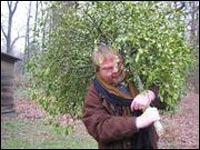From a bird’s eye view! – Are mistletoes indicators for soil pollution?

Prof. Dr. Dr. Ewald Schnug with mistletoe. Photo: FAL-PB
A Christian legend has it that the mistletoe was damned by God to a parasite’s life, because Christ’s cross was made out of its wood. It was hold sacred by ancient Teutons as it symbolised the continuity of life and fertility because of living between heaven and earth, and staying green even in winter. From this belief the tradition of kissing under the mistletoe at Christmas still dates back. Druids (and who does not know Miraculix in the world-famous comic series “Asterix”!?) cut them with golden sickles at top-secret places at the turn of the year and from them they brewed all kinds of healing and magic drinks.
The spots, where the mistletoes (Latin: Viscum album, i.e. “white slime” and points to the berries’ sticky features) grow, are not secret anymore. They occur massively in northern Germany. The mistletoes may gain considerable dimensions and are an enormous burden for the host due to their sheer weight and demand for nutrients. So, a mistletoe may easily weigh 15 kg and have a diameter of 1.5-m (see picture 1).
For the propagation of the mistletoes many factors are important such as the type of host tree, birds’ species, microclimate, and last but not least the individual resistance of the host. Scientists of the Institute of Plant Nutrition and Soil Science of the Federal Agricultural Research Centre (FAL) in Braunschweig, Germany, are investigating, how soil pollution with heavy metals might be related to the predisposition of the trees and vice versa the existence of mistletoes indicates such stress. By means of a Geographical Information Systems (GIS) the scientists overlay geographical and soil information with the appearance of mistletoes. Aerial images taken at low altitude are collected either from miniature planes or from a remote-controlled “aerosonde”, better known to the public as “drones” from war reports during the past years. The FAL-scientists work closely together with the colleagues of the German Centre for Aerospace (DLR) in Braunschweig, which use a so-called Micro-Airlab for taking images.
For the differentiation between host tree and mistletoe the scientists employ colour infrared photography (CIR). On such pictures intact green leaf tissues appear intensively red revealing a distinct contrast between mistletoes and trees as well as surrounding patterns (photo 2) which makes them easy to count.
Contacts: Prof. Dr. Dr. Ewald Schnug, Federal Agricultural Research Centre (FAL), Institute of Plant Nutrition and Soil Science, Bundesallee 50, D-38116 Braunschweig, phone +49 531 596 2101, E-mail: pb@fal.de
Media Contact
All latest news from the category: Life Sciences and Chemistry
Articles and reports from the Life Sciences and chemistry area deal with applied and basic research into modern biology, chemistry and human medicine.
Valuable information can be found on a range of life sciences fields including bacteriology, biochemistry, bionics, bioinformatics, biophysics, biotechnology, genetics, geobotany, human biology, marine biology, microbiology, molecular biology, cellular biology, zoology, bioinorganic chemistry, microchemistry and environmental chemistry.
Newest articles

Machine learning algorithm reveals long-theorized glass phase in crystal
Scientists have found evidence of an elusive, glassy phase of matter that emerges when a crystal’s perfect internal pattern is disrupted. X-ray technology and machine learning converge to shed light…

Mapping plant functional diversity from space
HKU ecologists revolutionize ecosystem monitoring with novel field-satellite integration. An international team of researchers, led by Professor Jin WU from the School of Biological Sciences at The University of Hong…

Inverters with constant full load capability
…enable an increase in the performance of electric drives. Overheating components significantly limit the performance of drivetrains in electric vehicles. Inverters in particular are subject to a high thermal load,…





















